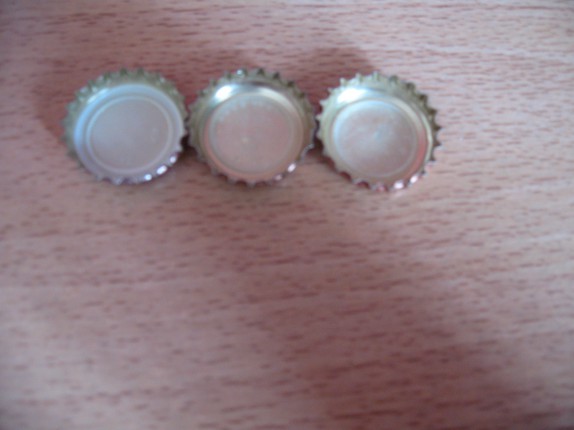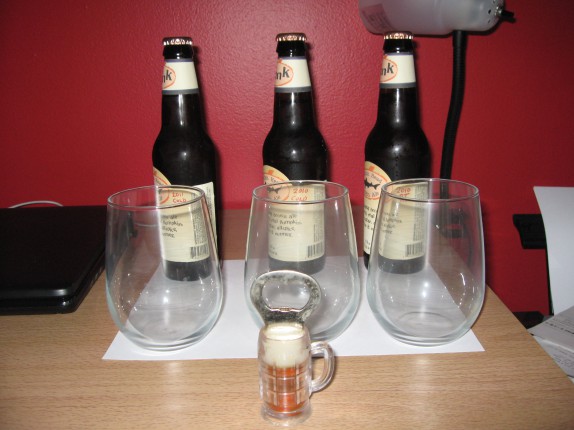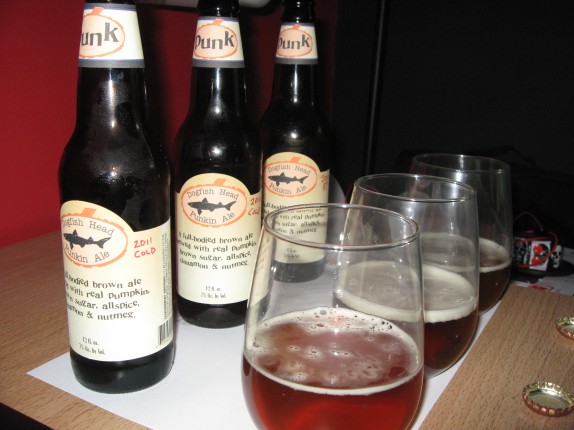derryXperiment: Aging Pumpkin Beer (1 Year)
Purpose: Study the effects of dark aging Dogfish Head Punkin Ale for approximately 1 year at room temperature.
Hypothesis: Aging of dark and flavored beers containing a higher-than-average alcohol by volume (ABV) leads to deepening of flavor. Theoretically, decomposition reactions between flavorings and ethyl alcohol lead to production of new and sometimes favorable flavors.
Experimental Procedure: Dogfish Head Punkin Ale (ABV 7.0%) was purchased in the fall of 2010. One four pack was placed in a refrigerator (35-40 deg F) upon purchase (deemed “2010 Cold”); another four pack from the same production lot was placed in the dark (i.e. a closet) at room temperature at the same time (deemed “2010 RT”). Approximately one year later, the RT stored 4 pack was moved to the same refrigerator. One bottle of beer from each lot was analyzed by derryX side by side along with a bottle manufactured in 2011 (also refrigerated — deemed “2011 Cold”).
Approximately half of each beer was poured into identical glasses, the design of which was chosen to allow accumulation of aroma, over a white sheet of 8.5 x 11 inch copy paper. Upon the initial pour, the parameters recorded were head, body color, aroma, and taste.
The remainder of each beer was poured into each glass, and the beer was allowed to equilibrate at room temperature for 30 minutes, at which point the same parameters were recorded.
Photographs (above) were captured to substantiate visual observations.
Results:
Head – The head of the 2011 beer deflates very quickly (within 30 seconds) upon the pour with no agitation. The heads of both 2010 beers are strong and sustained. The 2010 RT beer deflates slightly quicker than the 2010 cold.
Color – The appearance of the 2011 and 2010 Cold beers are very similar. Both are very brown with a red or orange hue; both are also transparent. The 2010 RT beer is much more gold than brown and much less red and orange; it is also cloudy and translucent.
Smell – 2011 Cold emits a very strong hops aroma; spices also pop with nutmeg being the most prevalent. 2010 Cold emits much less hops and spice aromas than 2011 Cold. The hops smell of 2010 RT is in line with 2010 Cold; however, there is an additional sweetness (like caramel) to the aroma, and there is almost no spice aroma. After 30 minutes, the smells of each beer are more or less the same as initial.
Taste – 2011 Cold has a very strong malt character at the start; next, spices and aroma are sensed, and the bitterness of the hops comes last. 2010 Cold has a strong malt and spice profile at the start; the spice is much stronger than 2011 Cold. The hops flavors are comparable between the two. 2010 RT is much more rich than the other two; it also has a texture (mouth feel) that is absent from the other two. The malt flavor is much more bold (sweet); the spices are dull and slightly bitter; the hops flavors at the end are consistent with the other two.
After 30 minutes, 2011 Cold tastes approximately the same. 2010 Cold became somewhat more bitter. 2010 RT became more fruity in character, but the flavor was very similar to the initial pour.
Additional Comments – Visual comparison of the caps used show that the polymer portion of the cap in 2011 is much more substantial than those from 2010. It is unclear whether this is due to use of caps with differing compositions in each year or whether degradation of the polymer portion of the caps in 2010 has taken place.

Conclusions:
- 2011 Cold may be an inferior beer (taste-wise) to 2010 Cold.
- Maintaining beer at room temperature clearly alters the color, smell, and flavor of the beer. In the case of Dogfish Punkin Ale, this seems to be a favorable change over time. In the opinion of the analyst, the additional sweetness and texture in the beer aged for approximately one year as well as the depth of the bitterness of the spices and decomposition products there of makes this a much more interesting thing to drink.
Future Experimental Improvements:
Intermediate Precision – Multiple analysts would add to the weight of this study. If anybody would like to perform the same analysis, there are two bottles each of 2010 Cold and 2010 RT available, which means two more people can try this as long as you buy your own bottle of 2011 and commit to analyzing all three under the above conditions. Send me an email, and we can arrange something.
Analysis of 2010 Cold and 2010 RT after 2 years – This experiment is currently being prepared.





Advertisement